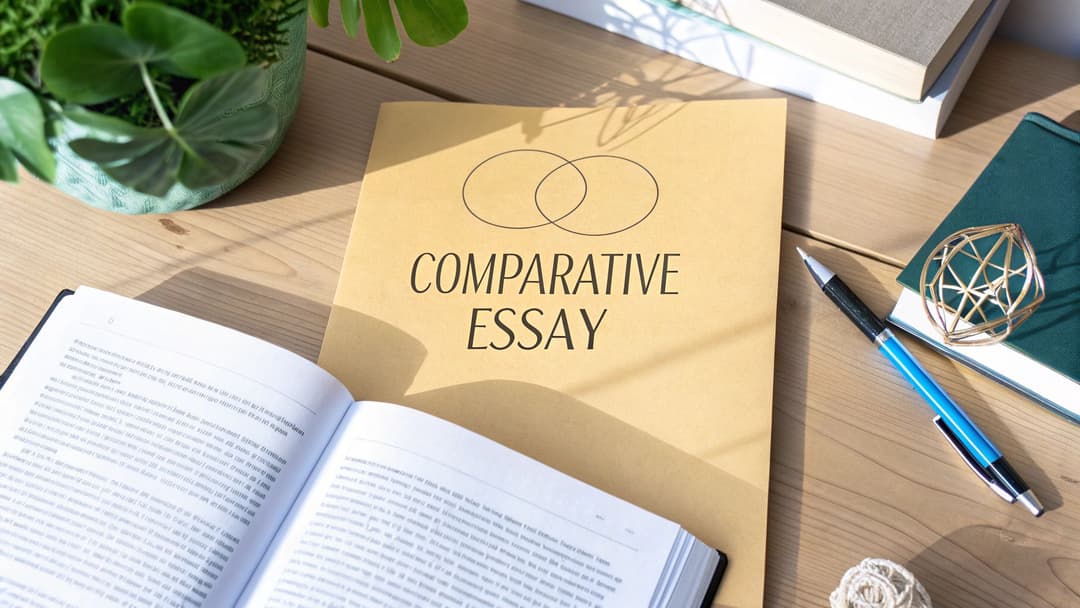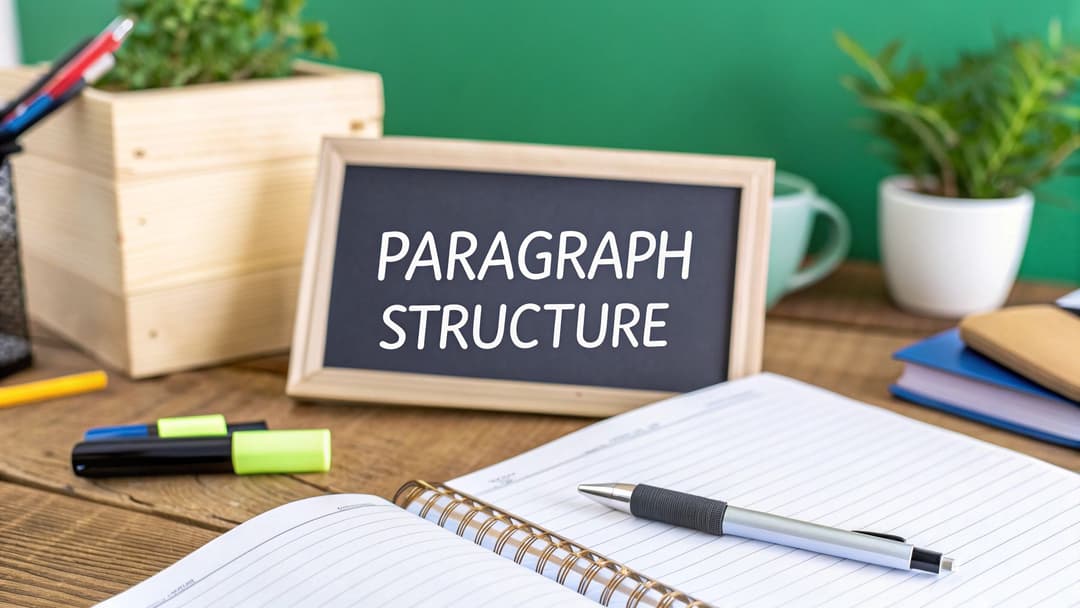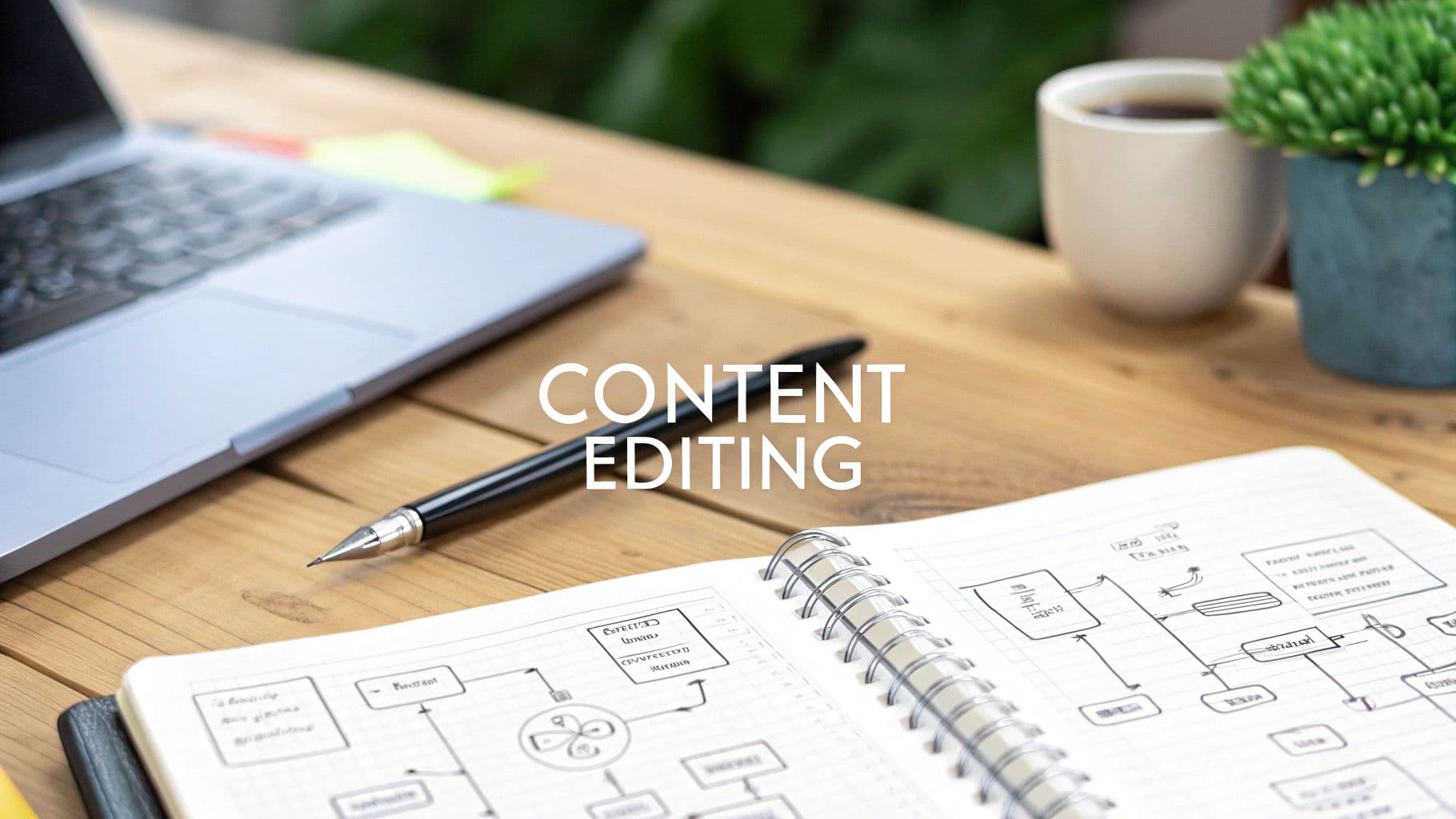
What Is Content Editing An Essential Guide
October 11, 2025
So, what exactly is content editing? It’s the art of looking at a piece of writing and asking the big questions before it gets a final polish. This isn’t about fixing typos or hunting for misplaced commas. It’s about making sure the core message lands, the arguments hang together, and the whole thing actually does what it’s supposed to do—whether that's to inform, persuade, or just keep someone reading.
The Architect Behind Great Content

Think of a content editor as the architect of an article. Long before anyone picks out paint colors or arranges furniture (that’s more like copyediting), the architect is making sure the foundation is solid. They check that the layout makes sense and the whole structure works as a single, functional unit. That's exactly what a content editor does for your writing.
An editor steps back from the individual sentences to see the entire piece. They’re focused on substance, not just style, asking the tough questions that turn a simple draft into something powerful. It’s a job that’s less about grammatical perfection and more about strategic impact.
What Does a Content Editor Actually Do?
Instead of getting lost in the weeds of grammar, a content editor focuses on the high-level stuff that makes or breaks a piece of content. Their real job boils down to a few key things:
- Sharpening the Core Message: They make sure your main point is crystal clear and rings true from the first word to the last.
- Fixing the Structure and Flow: This often means rearranging paragraphs, moving sections around, or reordering ideas to guide the reader on a more logical path.
- Boosting Clarity and Readability: If a sentence is confusing or a concept is too dense, they’ll rewrite it to make sure your target audience can actually understand it.
- Verifying Facts and Claims: They double-check your data, sources, and statements to ensure everything is credible and trustworthy.
In essence, a content editor’s job is to guarantee that the content not only says what you mean but also resonates deeply with the intended reader, prompting them to think, feel, or act.
You really can't overstate the value of this kind of strategic oversight. In today's digital world, where grabbing and holding attention is everything, it’s fundamental. Just look at the global content marketing industry—it exploded from $36.8 billion in 2018 to a staggering $413.3 billion in 2022. That massive jump shows just how much businesses rely on sharp, well-edited content to connect with people. If you want to dig deeper, you can explore more about the growth of content marketing to see just how big this has become.
Understanding the Core Pillars of Editing

To really get what content editing is, you have to break it down. An editor doesn’t just give a draft a quick read-through; they look at it through a few different lenses, each one zeroed in on a specific part of what makes the content work. This isn’t about just having an opinion. It’s a structured way to turn a pretty good draft into something great.
The whole thing starts from a bird's-eye view. Before getting tangled up in word choice, a good editor looks at the big picture. They’re asking the tough questions: What’s this piece trying to do? And does this draft actually pull it off?
Structural Integrity and Logical Flow
The first pillar is structural integrity. Think of this as checking the article’s skeleton. Does the intro actually hook the reader and tell them what’s coming? Do the arguments flow logically, or are good points just scattered all over the place?
An editor might move whole paragraphs around or even suggest adding a new section to fill a gap in the story. They’re making sure the piece has a real beginning, middle, and end, leading the reader on a smooth journey from one idea to the next.
A content editor’s main goal is to elevate your content and make it shine. That could mean rewriting sections, rearranging entire paragraphs, or suggesting you delete a subsection and add a new one. It's a highly collaborative and strategic process.
This big-picture work is everything. A piece can have flawless grammar, but if the structure is a mess, the message gets lost. The editor makes sure the foundation is solid before anything else happens. If you're trying to get better at this yourself, digging into different writing revision strategies can give you a solid playbook for this kind of structural check.
Sharpening Clarity and Voice
The second pillar is all about clarity and voice. Once the structure is solid, the editor zooms in a little closer to focus on the message itself. Is the language clear and easy for the target audience to get? Are you explaining complicated ideas simply, or burying them in jargon?
Here, the editor becomes the reader's champion. They'll rephrase clunky sentences and make the main point sharper. They also keep a close eye on maintaining a consistent brand voice. An editor ensures the tone—whether it's authoritative, friendly, or formal—doesn't wobble, which helps reinforce who you are. This is what makes sure the content doesn't just make sense, but actually connects with a real person.
Content Editing vs Copyediting Demystified
It's one of the most common mix-ups in the writing world, but let's clear the air. Telling the difference between content editing and copyediting is actually pretty simple once you have the right analogy.
Think of it like building a house. The content editor is your architect, and the copyeditor is your interior designer.
The architect (content editor) is all about the big picture. They’re focused on the blueprint—making sure the foundation is solid, the rooms flow into each other logically, and the whole structure serves its purpose. They aren’t worried about the paint color on the walls just yet. Their job is to make sure the house will stand strong.
Then, the interior designer (copyeditor) comes in. They work inside the structure the architect designed, perfecting all the little details. They choose the right paint, fix scuff marks on the baseboards, and make sure every finish is flawless. They make the house beautiful and move-in ready, but they aren't tearing down walls.
Big Picture vs. Fine Details
This house analogy gets to the heart of it: a content editor digs into the substance of your work. They ask the tough, strategic questions to make sure your arguments land, your message is clear, and the entire piece actually does what you want it to do.
A content editor is asking things like:
- Is this argument actually convincing? Where's the proof?
- Does this structure make sense, or will the reader get lost?
- Is the tone right for who we're talking to?
- Are there any obvious gaps in logic or information here?
A copyeditor, on the other hand, works at the sentence level. They are the masters of mechanics, cleaning up grammar, punctuation, and style. They're the ones who give your content that final, professional polish.
A content editor strengthens the 'what' and 'why' of your message—the core ideas and strategy. A copyeditor perfects the 'how'—the grammar, syntax, and style used to express those ideas.
To make this even clearer, let's break down exactly what each role is responsible for.
Content Editing vs Copyediting Key Responsibilities
| Area of Focus | Content Editing (The Architect) | Copyediting (The Interior Designer) |
|---|---|---|
| Primary Goal | Strengthen the core message, structure, and argument. | Correct errors in grammar, spelling, and punctuation. |
| Scope | Big-picture, holistic view of the entire piece. | Sentence-level, word-by-word precision. |
| Key Questions | "Is this clear? Is it persuasive? Does it flow?" | "Is this correct? Is it consistent? Does it follow the style guide?" |
| When they engage | Early in the drafting process. | Late in the process, before publication. |
| Example Task | Recommending a new section to support an argument. | Fixing a comma splice or a subject-verb agreement error. |
As you can see, these roles aren't just different—they're sequential. You wouldn't hire an interior designer before the walls are even up.
This infographic lays out the key distinctions beautifully, showing where each role fits into the workflow.
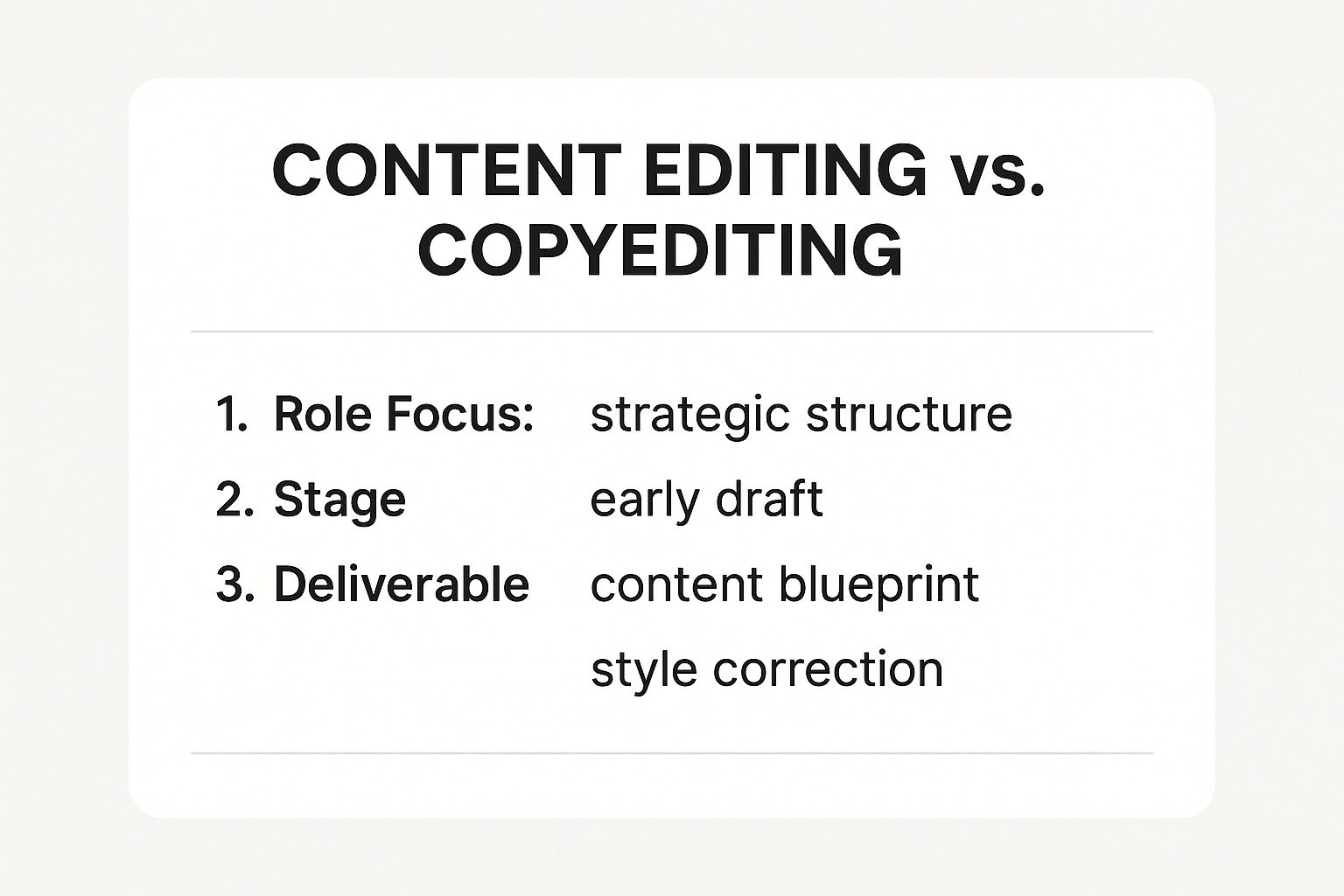
Ultimately, you need both. Great content requires the architectural vision of a content editor and the detailed finish of a copyeditor. One builds the foundation, and the other makes it shine. Skip a step, and the final result will always feel incomplete.
Exploring Different Types of Content Editing
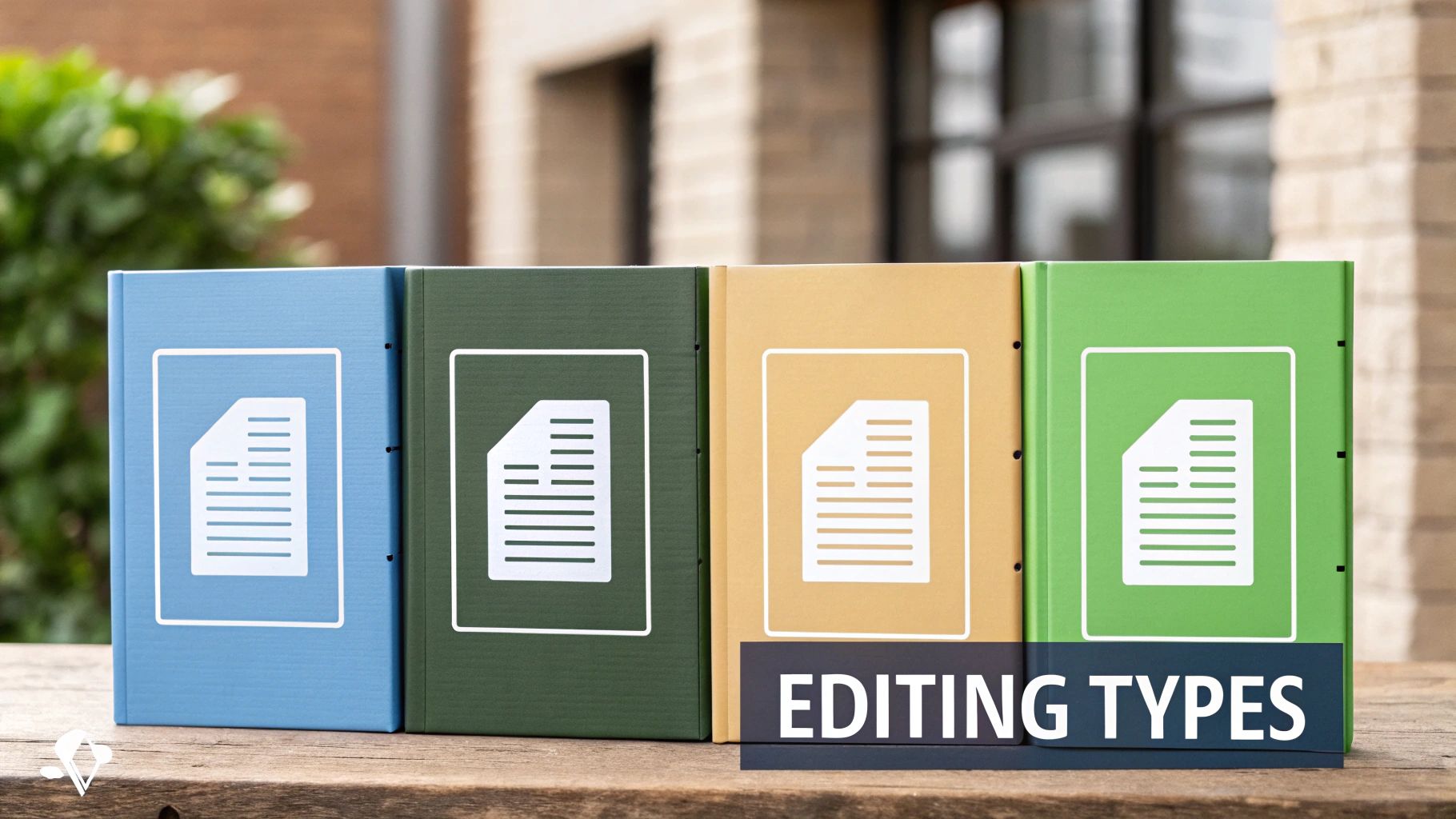
Content editing isn't one single job. It’s a whole collection of specialized skills, and knowing the difference is key to getting the right help for your project.
Think of it this way: a general contractor knows when to call a plumber versus an electrician. In the same way, a smart content creator knows which type of editor to bring in for the job. Some editors jump in at the earliest stages of an idea, while others are all about polishing a nearly finished piece for a specific audience.
Let's break down the most common specializations you'll run into.
Developmental Editing: The Blueprint Phase
Developmental editing is the first stop. It's the most foundational type of editing, where an editor works with an author on a raw idea or a very rough first draft. The goal here is to shape the core concept, structure, and direction of the piece before you've even invested much time into writing it.
Your developmental editor is basically a co-architect for your content. They’ll help you:
- Refine a Vague Idea: Get crystal clear on your main point and who you're talking to.
- Build the Structure: Create a logical outline to make sure your arguments flow smoothly.
- Identify Content Gaps: Spot missing information or weak spots in your logic right from the start.
This is a must-have in book publishing, but it’s just as valuable for major business assets like white papers, in-depth guides, or cornerstone blog posts.
Substantive Editing: Strengthening The Core
Substantive editing (sometimes called structural editing) comes into play once you have a complete draft. The editor dives deep into the manuscript to improve its overall quality, focusing on the substance of the content, not just the grammar or style.
A substantive editor looks at your draft’s logic, clarity, and persuasive punch. They might reorder entire paragraphs, suggest rewriting sections that are confusing, and check that every claim is properly supported. Their mission is to make sure your piece isn't just well-written, but that it’s actually effective and compelling.
Substantive editing is where the raw material of a draft is molded into a powerful, coherent message. It ensures the "what" of your content is as strong as the "how" it's written.
SEO Editing: Optimizing for Visibility
SEO editing is a special skill that blends traditional editing with the principles of search engine optimization. The whole point is to boost a piece's ranking on search engines like Google without making it sound robotic or sacrificing quality.
An SEO editor will:
- Weave relevant keywords into the text naturally.
- Optimize headings, meta descriptions, and image alt text.
- Strengthen internal linking to build topical authority.
- Make sure the content is structured in a way that's easy for search engines to crawl.
This is absolutely critical for any digital content. After all, even the most brilliant article is useless if no one can find it.
Video Content Editing: The Visual Narrative
Finally, video content editing has exploded into a massive field of its own. Video editors take raw footage and craft a compelling visual story. This means cutting scenes, adding music and graphics, and pacing the narrative to keep viewers hooked from start to finish. For anyone just getting started, guides on easy video editing for beginners can be a great place to start.
You can't overstate how important this specialty is. The global video editing software market is projected to hit $5.13 billion by 2032, with an estimated 48.22 million users expected to have paid subscriptions by 2025. This industry is only getting bigger.
How Modern Tools Are Transforming the Craft
Technology isn't here to replace skilled content editors. It's here to give them a serious upgrade.
The old way of passing a single document back and forth is fading fast. In its place, we have a much more dynamic, collaborative environment where editors can work faster and focus on big-picture strategy instead of getting bogged down in administrative tasks.
This shift really took off with tools like Google Docs, which made real-time feedback and simultaneous editing the new normal. Working in the cloud has streamlined the entire process, letting writers and editors fix issues on the fly with total transparency.
The Rise of AI-Assisted Editing
More recently, AI-powered platforms have joined the party. These tools aren't trying to take over the job; they're acting as a powerful assistant. They can run a quick first pass for structural problems, flag clarity issues, and check for consistency across a massive document—all things that used to eat up hours of manual work.
By handing off these repetitive tasks, AI frees up human editors to do what they do best. They can focus on high-level strategy, dig into the nuances of a piece, and make sure the content genuinely connects with the reader on both an emotional and intellectual level. To get a real sense of this, it helps to know the essential apps for content creators that power today's workflows.
The modern editor’s toolkit is a blend of human artistry and technological precision. AI can spot a recurring weak phrase, but only a human can determine if the underlying argument is compelling.
A Growing Market for Enhanced Content
This whole evolution is happening inside a booming industry. The digital content creation market, where sharp editing is non-negotiable, was valued at $27.1 billion in 2023 and is expected to hit $34.5 billion by 2025. That growth just underscores the surging demand for polished, high-quality content that cuts through the noise.
This mix of human expertise and smart technology is a winning formula. It doesn't just speed things up; it elevates the final product.
The editor of today is part artist, part strategist, and part technologist, using a sophisticated set of tools to get outstanding results. This evolution also ties directly into the final purpose of a piece, which is a key part of what is content optimization. The goal is no longer just to fix mistakes but to build content that hits specific business goals and performs exceptionally well.
Common Content Editing Questions Answered
So, you understand what a content editor does. But when it’s time to actually hire one or level up your own skills, the practical questions start popping up. We’ve all been there.
Let’s get straight to the real-world questions you’re probably asking yourself.
How Much Does Professional Content Editing Cost
This is always the first question, isn’t it? And the honest answer is: it depends. The cost of bringing in a pro can swing pretty widely based on a few key things.
An editor’s experience, the complexity of your topic, and how fast you need it done all play a role. Generally, you’ll see one of three pricing models:
- Hourly Rate: Lots of freelance editors charge by the hour, with rates anywhere from $40 to over $100. This makes sense for projects where the scope isn't totally nailed down.
- Per-Word Rate: This is super common for articles and manuscripts, usually falling between $0.03 and $0.10+. It gives you a clear, upfront cost based on your draft's length.
- Project Fee: For bigger, well-defined projects, an editor might just give you a flat fee for the whole thing.
Before you agree to anything, always ask for a detailed quote. Make sure it spells out exactly what’s included—like how many rounds of revision you get—to avoid any surprises down the road.
Can I Effectively Edit My Own Writing
Yes and no. Self-editing is a crucial first step, but it’s nearly impossible to be objective about your own writing. You know what you meant to say, which makes it incredibly easy to gloss over logic gaps or unclear sentences.
A professional content editor brings the one thing you can’t: a fresh perspective. They come in cold, so they can spot the weak points a writer is just too close to see.
It's like trying to spot a typo on a sign you designed yourself—your brain just auto-corrects it. That second set of eyes is truly invaluable. If you want to get better at that first pass, a good self-editing checklist will help you catch the obvious stuff before you hand it off.
When Is the Right Time to Hire a Content Editor
Timing is everything. You want to bring in a content editor at the sweet spot: after you’ve finished a complete first draft, but before you send it to a copyeditor.
At this point, your main ideas are on the page, but the structure, flow, and arguments probably need some love. This is where a content editor really shines.
- Too Early: If you bring them in with a half-baked draft, they might spend hours polishing ideas you end up scrapping later. It’s a waste of time and money.
- Too Late: Handing a draft to a content editor after it's been copyedited is a recipe for frustration. If they suggest big structural changes (and they often do), the whole piece will have to be copyedited and proofread all over again.
Getting the timing right means their feedback will have the biggest possible impact, setting you up for a much smoother final polish. It saves time, money, and a whole lot of headaches.
Ready to refine your AI-generated drafts into polished, human-like content? Natural Write instantly humanizes your text, ensuring it flows naturally and bypasses AI detection tools with a single click. Try Natural Write for free and transform your writing today.
